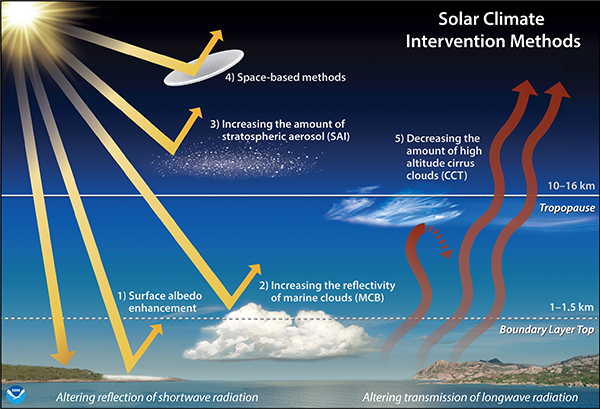A .gov website belongs to an official government organization in the United States.
A lock () or https:// means you've safely connected to the .gov website. Share sensitive information only on official, secure websites.
14 May 2021
adapted from the story by NOAA Communications

The dynamics that lift smoke from large wildfires into the upper atmosphere could potentially be employed one day to help temporarily cool the planet, based on the findings of a modeling study led by NOAA scientists.
Inspired by a giant fire cloud generated over the Pacific Northwest in 2017, the author team investigated whether heat from the sun could loft light-reflecting material mixed with heat-absorbing particles several miles into the stratosphere from lower altitudes. Once in the stratosphere, the reflective material would dim sunlight and cool the planet below. A description of the process, called solar-powered lofting, was published in the journal Science Advances.
The NOAA-led team, which also includes scientists from CIRES, NCAR, the University of Colorado, the German Aerospace Center, and Jinan University in China, used the NCAR Community Earth System Model to simulate solar-powered lofting in order to calculate the amount of light-absorbing black carbon particles required to effect substantial lofting. The suitability of the model was demonstrated by successfully reproducing the lofting in the 2017 Pacific Northwest fire plume.
"Greenhouse gases continue to increase, and there is concern that at some point the Earth system will reach a tipping point that it can't return from," said Karen Rosenlof, a NOAA researcher at CSL and one of two NOAA lead authors of the paper. "Reflecting sunlight with stratospheric aerosols, effectively mimicking what large volcanic eruptions do, may buy some time for decarbonization efforts to ramp up. We don't have the technology to do this today, but nature has shown us one way someone might propose to do it in the future."
The scientists conclude that solar-powered lofting is potentially feasible with existing aviation technology. It could also be easier, less expensive, and just as effective as introducing aerosols directly into the stratosphere, they said. Model simulations show that as little as 10 micrograms of heat-absorbing black carbon per cubic meter would be enough to loft air that also contained sulfur dioxide, which converts to light-reflecting particles, into the lower stratosphere in just a matter of days.
There are currently no aircraft or other platforms that can directly deliver large amounts of aerosol material or aerosol precursors to altitudes 12 miles or higher and disperse the material evenly. Even less effort has been invested in understanding the practical aspects of aerosol injection in the stratosphere.
It's been long recognized that large volcanic eruptions are often followed by periods of global cooling, as sulfur dioxide gas ejected into the stratosphere converts gradually into sulfate particles that dim incoming sunlight and decrease surface temperatures for periods ranging from months to a few years.

More recently, scientists have observed that large wildfires can create tall plumes of smoke which reach the stratosphere. Scientists studying the 2017 Pacific Northwest fires concluded that a pyro-cumulonimbus plume associated with the extensive wildfires had injected the largest amount of mass into the stratosphere observed from a Northern Hemisphere wildfire to date, providing a real-world demonstration of the physical mechanism explored in the modeling study.
A pillar of smoke generated by the fire included an estimated 300,000 metric tons of smoke which was carried to more than 7 miles in the upper troposphere by the intense heat and updrafts caused by the fire. Over the next two months, smoke particles rose another 7 miles – into the stratosphere – and persisted for nine months following the fires.
Rosenlof said the intent of this study is not to encourage implementation of planet-cooling methods, but to provide the scientific foundation for societal decision-making. The scientists associated with this study acknowledge, as have many other scientists, that increasing the stratospheric burden of aerosols would likely have unintended consequences, such as increased stratospheric temperatures, changes in surface precipitation patterns, and potentially depletion of the stratospheric ozone layer that absorbs harmful ultraviolet radiation.
In 2020, NOAA initiated the Earth's radiation budget (ERB) research program to establish the scientific foundation needed to inform decision makers who may one day evaluate climate intervention proposals. NOAA scientists and partners are investigating the climate effects of aerosols potentially added to the stratosphere and troposphere, and evaluating modeling systems that realistically assess aerosol impacts on the Earth system and on society. Research into atmospheric aerosols will also improve weather and climate models.
NOAA has no plans to conduct experiments in the atmosphere that demonstrate this or any other climate intervention method. Any decision to implement climate intervention activities will be made outside of NOAA.
Gao, R.-S., K.H. Rosenlof, B. Kärcher, S. Tilmes, O.B. Toon, C. Maloney, and P. Yu, Toward practical stratospheric aerosol albedo modification: Solar-powered lofting, Science Advances, doi:10.1126/sciadv.abe3416, 2021.
Many climate intervention (CI) methods have been proposed to offset greenhouse gas–induced global warming, but the practicalities regarding implementation have not received sufficient attention. Stratospheric aerosol injection (SAI) involves introducing large amounts of CI material well within the stratosphere to enhance the aerosol loading, thereby increasing reflection of solar radiation. We explore a delivery method termed solar-powered lofting (SPL) that uses solar energy to loft CI material injected at lower altitudes accessible by conventional aircraft. Particles that absorb solar radiation are dispersed with the CI material and heat the surrounding air. The heated air rises, carrying the CI material to the stratosphere. Global model simulations show that black carbon aerosol (10 microgram per cubic meter) is sufficient to quickly loft CI material well into the stratosphere. SPL could make SAI viable at present, is also more energy efficient, and disperses CI material faster than direct stratospheric injection.